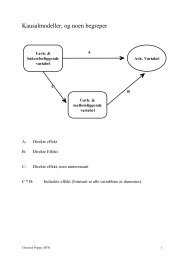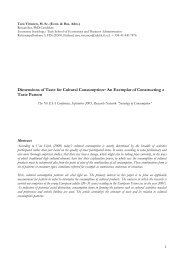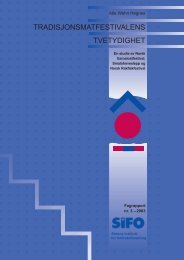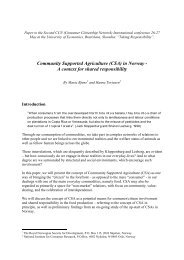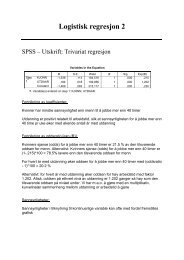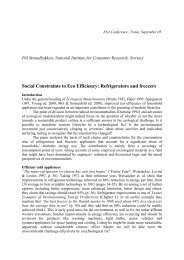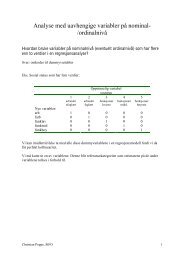Rapport nr - SIFO
Rapport nr - SIFO
Rapport nr - SIFO
- No tags were found...
You also want an ePaper? Increase the reach of your titles
YUMPU automatically turns print PDFs into web optimized ePapers that Google loves.
8 Consumer8.1. Knowledge of consumers on local foodThere currently exits two types of consumers: the local consumer who knows the product and its territory,and those who are ignorant about the product.Local consumers prefer seasonality in their products. Waiting time is an added value for this consumer.Therefore, it can explain the very rapid increase in the number of open market of producers.For instance, the creation of the brand Marché de producteurs de pays by the Aveyron Chamber ofAgriculture has been made to organise local open markets which guarantees quality and proximity toconsumers, thanks to the adhesion of the producers to a quality charter. The relationship betweentypicity and means of commercialisation is very strong, and therefore a product does not really havethe same “local” meaning if it comes from a local market, a farm or a hyper market. This is why a lotof producers want to create open markets or markets at farms in order to sell their products directly toconsumers, although there is a risk when transferring a job between a producer and a seller. To avoidthis loss of identity, networks of producers develop charters to regulate the open market which are organisedby themselves and their members. The network Bienvenue à la Ferme, for example, is creatinga partnership with the brand Marché de producteurs de pays to able to use their charter for theiropen markets to prevent the possible loss of identity and quality if the producers only become sellers.8.2. Conviviality and consumption habitsThe means of consumption influence the choice of a product in many cases. Conviviality and sharingcan be a justification for labelled products assimilated to quality of life and pleasure. Eating labelledproducts can also be a means to show culture Nevertheless, there are also decisions based on consumptionhabits: when you know the product, when you are familiar with consuming it, you will buy iteasier than a consumer who is unfamiliar with this product, since food products express all their interestsonly when you taste them.Marketing is a means to inform consumers about the characteristics of the product, while taste is theonly means to keep a consumer purchasing the product. A consumer who had a positive experiencewith the product will buy it again. However, if the taste does not correspond to consumer expectations,it will be nearly impossible to make he or she buys this product again, even with the best marketing.Taste is important today, but factors like packaging also play a key role in product choice.For no-local consumers, regularity of taste is also important. Consumers want a predictable productthat is without variation and surprise.Consumers from newer generations (less than 25 y.o.) seem to have another vision concerning a respectof tradition. Only 35% said that agriculture must respect traditions compared to 63% for consumersgreater than 65 y.o. (BVA survey 2003)




